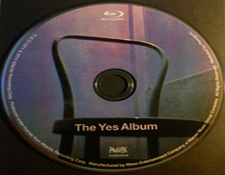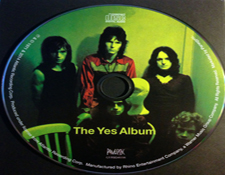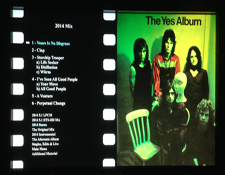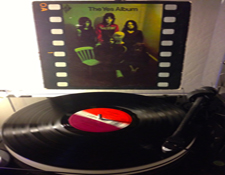It’s the time of year for saving money!
The 2014 arrival of Yes’ third recording, circa 1971, on Blu-Ray is an exciting moment in surround sound — and prog rock — history. After all, here we have, one of the earliest examples of a genre that would soon become known as progressive rock music, now being presented in a high resolution (96 kHz, 24-bit) formats and remixed into immersive multi-channel sound.
 This period — from 1969 through 1972 — was an incredibly fertile incubation time for this type of music. Spearheaded (arguably) by the 1969 King Crimson release, In the Court of the Crimson King, other bands and musicians were challenged and inspired. Suddenly a number of groups playing more expansive music stepped up to the bar (and many were snapped up by labels sensing the next big trend in music) in fairly rapid succession, releasing genre-defining albums including the first two albums by Emerson Lake and Palmer, early recordings by Genesis, Nektar, Gentle Giant, Tangerine Dream …. Jethro Tull’s Aqualung and Thick as a Brick… and this third album by Yes.
This period — from 1969 through 1972 — was an incredibly fertile incubation time for this type of music. Spearheaded (arguably) by the 1969 King Crimson release, In the Court of the Crimson King, other bands and musicians were challenged and inspired. Suddenly a number of groups playing more expansive music stepped up to the bar (and many were snapped up by labels sensing the next big trend in music) in fairly rapid succession, releasing genre-defining albums including the first two albums by Emerson Lake and Palmer, early recordings by Genesis, Nektar, Gentle Giant, Tangerine Dream …. Jethro Tull’s Aqualung and Thick as a Brick… and this third album by Yes.
Springboarding off of the dense harmonic sounds The Beatles layered up on their swan song, Abbey Road, The Yes Album to strove to create a richly immersive progressive sound beyond the standard faire of most rock bands, showcasing astounding musicianship more common to the worlds of jazz and classical musics.
Recorded on 16-track multi-channel analog tape, Blu-Ray producer Steven Wilson has been able to create a wonderfully immersive environment from these arguably journeyman-like tapes, a recording with a very distinct feel. Evoking a similar vibe that honors the original mix in a surround soundscape was no doubt a significant challenge on The Yes Album.
 That said, don’t go into listening to this expecting Wilson’s new surround-sound mix to sound identical to the stereo. Part of the joy of this release is that it does indeed sound quite a bit different. Wilson wisely keeps the basic core rock trio of the band (drums, bass, guitar) in the front channels, using the surrounds for keyboard flourishes, guitar pyrotechnics and select vocal harmony parts. Because of the dense nature of the original mix, some of the elements which were designed to work tightly with one another in a stereo mix take on an alternate flavor once it is broken out into surround sound. Don’t worry — things don’t fall apart (as can be the case with some rock recordings, one of the reasons The Rolling Stones have never done surround mixes of their albums), but the music does take on a feel that is… well… different!
That said, don’t go into listening to this expecting Wilson’s new surround-sound mix to sound identical to the stereo. Part of the joy of this release is that it does indeed sound quite a bit different. Wilson wisely keeps the basic core rock trio of the band (drums, bass, guitar) in the front channels, using the surrounds for keyboard flourishes, guitar pyrotechnics and select vocal harmony parts. Because of the dense nature of the original mix, some of the elements which were designed to work tightly with one another in a stereo mix take on an alternate flavor once it is broken out into surround sound. Don’t worry — things don’t fall apart (as can be the case with some rock recordings, one of the reasons The Rolling Stones have never done surround mixes of their albums), but the music does take on a feel that is… well… different!
Is that bad? I certainly don’t think so!
But, it is what it is and it is thus is important to acknowledge and consider where the band was in 1971 with producer Eddie Offord. At this time, Yes was still very much a “rock band” dipping its toes in the waters of the progressive rock genre they would soon help to define. Thus The Yes Album captures a great live rock band using the studio as a tool, again much in the way that The Beatles did with Abbey Road. Together, this team grew in leaps and bounds just a year or two later for the increasingly symphonic-scoped albums Fragile, Close to the Edge and then ultimately Tales from Topographic Oceans.
 Yes fanatics should rest easy knowing that for the most part this new surround mix does mirror the original album’s intent. It sounds pretty amazing!! However there are moments of variation with little parts that pop up, sounds we’ve never heard before which were obviously buried in the original mix.
Yes fanatics should rest easy knowing that for the most part this new surround mix does mirror the original album’s intent. It sounds pretty amazing!! However there are moments of variation with little parts that pop up, sounds we’ve never heard before which were obviously buried in the original mix.
I for one welcome this sort of treatment. I know some purists however who do get a little bent out of shape by the sort of thing, but I feel that makes it interesting and another reason to explore the surround mix.
The point is: it should not be surprising that the surround mix on The Yes Album would sound very different — simpler, if you will — than what they were able to do with, for example, Close to the Edge (which was released just last year to spectacular effect on Blu-Ray, also mixed by Steven Wilson).
 The Blu-Ray of The Yes Album also includes numerous additional 96 kHz / 24-bit mixes for the listener to choose from including a “flat,” uncompressed transfer of the original two-track stereo mix. There is a brand-new 2014 stereo mix done by Steven Wilson (which sounds nice, if quite a bit drier — less reverb/ambiance, and thus a bit more modern in that sense — than the original mix). You even get a “needle drop” transfer from an archival A1/B1 original 1971 UK pressing, which sounds pretty wonderful too (although I am not planning on getting rid of my A1/B1 UK LP any time soon!).
The Blu-Ray of The Yes Album also includes numerous additional 96 kHz / 24-bit mixes for the listener to choose from including a “flat,” uncompressed transfer of the original two-track stereo mix. There is a brand-new 2014 stereo mix done by Steven Wilson (which sounds nice, if quite a bit drier — less reverb/ambiance, and thus a bit more modern in that sense — than the original mix). You even get a “needle drop” transfer from an archival A1/B1 original 1971 UK pressing, which sounds pretty wonderful too (although I am not planning on getting rid of my A1/B1 UK LP any time soon!).
Also included are a wealth of bonus materials including single mixes/edits and a number of archival live tracks. There is a particularly enlightening and raw 1971 live rendition of Paul Simon’s “America” where you really get to hear how the band was working out all the parts of the arrangement, details which would eventually be fined tuned and recorded for posterity a year or two later in the studio (released on the 1975 Yesterdays compilation and remixed into 5.1 surround for the 2013 Blu-Ray of Close to the Edge). There is also an exclusive instrumental stereo mix of The Yes Album — yup, now you aspiring angelic voices can now do your very own Karaoke Yes session!
One really great feature of this Blu-Ray disc is the design of the on-screen interface, which accomplishes a nice blend of features for obsessive and casual listeners alike. For those who want to just hear the disc play without hassle, it is designed to just engage when you put the disc in and hit play just like a CD — it will default to the new DTS HD Master Audio 5.1 remix. On the navigation screen, all the options appear on the left side enabling easy juggling between sections — this is particularly useful when you want to compare and contrast the different versions of the album on the disc, you can jump from the new 2014 remix to the original 1971 mix in a heartbeat.
 The deluxe packaging on The Yes Album is lovingly created in a mini album sleeves that re-creates the look and feel of the original edition (including the flat matte texture of the UK pressings — US pressings were somewhat on the shiny side). It includes a large in-depth booklet with notes from the band about the making of the album, including many cool photographs.
The deluxe packaging on The Yes Album is lovingly created in a mini album sleeves that re-creates the look and feel of the original edition (including the flat matte texture of the UK pressings — US pressings were somewhat on the shiny side). It includes a large in-depth booklet with notes from the band about the making of the album, including many cool photographs.
All in all, this is a fine Blu-Ray release.
Oh yeah it also includes a CD of the stereo mix Steven Wilson made in 2014. That sounds really good too and will be good for the car. It does, however, indeed sound like a CD — most noticeably, I perceive a harsher, digital edge on the vocals and high end, mos
tly likely due to the compression down to 16-bit / 44.1 kHz file sizes required for making a CD.
For me however that point is moot since I won’t be spending much time with the CD anyhow. From here on out, my choice listen of The Yes Album will most likely be this new Blu-Ray disc, and the surround mix in particular. Once again I give Mr. Wilson heartfelt applause and also thank the band for making these remixes happen on behalf of all of us fans.
Now… please… onward to Tales from Topographic Oceans!
Mark Smotroff is a freelance writer and avid music collector who has worked for many years in marketing communications for the consumer electronics, pro audio and video games industries, serving clients including DTS, Sega, Sony, Sharp, AT&T and many others. www.smotroff.com Mark has written for EQ Magazine, Mix Magazine, Goldmine/DISCoveries Magazine, BigPictureBigSound.com, Sound+Vision Magazine and HomeTechTell.com. He is also a musician / composer whose songs have been used in TV shows such as Smallville and Men In Trees as well as films and documentaries. www.ingdom.com Mark is currently rolling out a new musical he’s written: www.dialthemusical.com.






